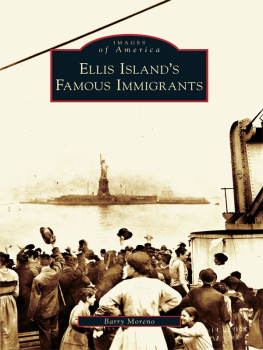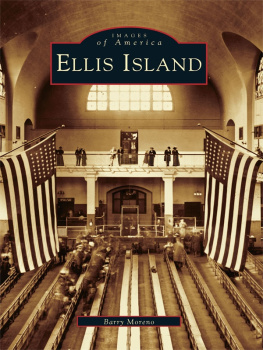American
Passage
The History of Ellis Island
VINCENT J. CANNATO

In Memory of
My father
Vincent John Cannato
(19302008)
and My grandfather
Vincent Joseph Cannato
(18931983)
Contents
BEFORE THE DELUGE
Island THE SIFTING BEGINS Feud
REFORM AND REGULATION
The Roosevelt Straddle
Likely to Become a Public Charge
Czar Williams
Moral Turpitude
iv Contents DISILLUSION AND RESTRICTION
Quotas
MEMORY
The New Plymouth Rock
Cover
Introduction
Ellis Island is one of the greatest human nature offices in the world; no week passes without its comedies as well as tragedies. William Williams, Ellis Island Commissioner, 1912
Ellis Island was the great outpost of the new and vigorous republic. Ellis Island stood guard over the wide-flung portal. Ellis Island resounded for years to the tramp of an endless invading army.
Harry E. Hull, Commissioner-General of Immigration, 1928
BY 1912, THIRTY-THREE-YEAR-OLD FINNISH CARPENTER Johann Tyni had had enough of America. I wish to go back to Finland. I didnt get along well in this country, he admitted less than three years after he and his family had arrived. The married immigrant with four children was depressed and unemployed. I worked too hard and I am all played out, he said. I am downhearted all the time and the thoughts make me cry.
The Reverend Kalle McKinen, pastor of Brooklyns Finnish Seamens Mission, had had enough of Johann Tyni. For the previous year and a half, Finnish charities had been taking care of the Tyni family. This man has been crazy since he landed here, McKinen wrote immigration officials. It is to be regretted that his family were [ sic ] ever admitted to this country. He also complained that Tynis wife was not very bright and could no longer care for her children. Out of a mixture of desperation, pity, and anger, Reverend McKinen brought the Tyni family to Ellis Island.
After observing Johann on the islands psychiatric ward, immigration officials decided that they too had had enough of the Tyni family. Doctors at Ellis Island diagnosed Johann with insanity characterized by depression, sluggish movements, subjective complaints of pain in the head and a feeling of inefficiency. They also declared that Johanns nine-year-old son, John, was a low grade imbecile who showed the characteristic stigmata of a mental defective.
The family had originally arrived at Ellis Island under much happier circumstances. With three children in tow, Johann and his wife arrived with $100 and presented themselves to authorities in good physical and mental health. Less than three years after coming to America, Johann, his wife, two Finnish-born sons, and two American-born children were deported back to Finland from Ellis Island, anxious to get back to Johanns mother-in-law to rebuild a life that did not make sense in America.
Something had clearly happened since they arrived. Though two more children were born after their arrival, the Tynis lost their twoyear-old Finnish-born son, Eugen, while living in Brooklyn. Perhaps the shock of his sons death, combined with a new, harsh, and unfamiliar environment, was enough to push Johann Tyni into a deep psychological abyss.
Immigration officials were not interested in the reasons for Tynis mental illness. They were only concerned that he could no longer work and support his family. In the official terminology, the entire Tyni family was deemed likely to become public charges, a designation that allowed officials to deport them back to their native Finland. Twoyear-old David and infant Mary, both citizens by reason of their birth on American soil, were not technically deported and could have remained in the country, but obviously joined their parents and siblings on the return trip to Finland.
By this time, the government could not only exclude immigrants at the border but also deport them after their arrival if they came under an excludable class. The specter of Ellis Island haunted not just those newly arrived immigrants awaiting inspection but also those who managed to land initially who could be threatened with deportation for three years after.
Unlike the Tyni family, some immigrants never got the chance to set foot on the American mainland before being sent back home. Eighteenyear-old Hungarian Anna Segla arrived a few months after the Tyni family in 1910. After the inspection at Ellis Island, doctors certified her as possessing curvature of spine, deformity of chest, as well as being a dwarf. They believed that those physical defects would prevent Anna from gaining meaningful employment in America. Anna Segla was ordered excluded.
Anna had been headed to live with her aunt and uncle in Connecticut. The childless couple had promised to take care of Anna and offered to post a bond for her release. For nearly two weeks, Anna was detained at Ellis Island while her case was appealed to officials in Washington. In a letter most likely written by her aunt and which Anna signed with an X , Anna eloquently made her case for admittance. I beg to say that the hunchback on me never interfered with my ability to earn my living as I always worked the hardest housework and I am able to work the same in the future, the letter stated. I pray Your Honor permit me to land in the United States. Despite her pleas, Anna was sent back to Europe.
Other immigrants were detained for even longer periods of time at Ellis Island, although many were eventually allowed to enter the country. When Louis K. Pittman came through Ellis Island in 1907 as a young boy, doctors discovered that he suffered from trachoma, a mildly contagious eye disease against which medical officials were especially vigilant. Rather than being deported, Pittman was allowed to stay in the islands hospitals while doctors treated his condition. Decades later, Pittman remembered his stay at Ellis Island as very pleasant, with toys, good food, playmates, and very lax supervision by adults. After seventeen months in custody at Ellis Islands hospital, Pittman was allowed to rejoin his family on the mainland.
Others, luckier than Pittman, were detained for shorter periods. Frank Woodhulls experience at Ellis Island began in 1908 when he returned from a vacation to England. The Canadian-born Woodhull, who was not a naturalized American citizen, was heading back to New Orleans where he lived. As he walked single file with his fellow passengers past Ellis Island doctors, he was pulled aside for further inspection. The fifty-year-old was of slight build with a sallow complexion. He wore a black suit and vest, with a black hat pulled down low over his eyes and covering his short-cropped hair. His appearance convinced the doctors to test Woodhull for tuberculosis.
Woodhull was taken to a detention ward for further examination. When a doctor asked him to take his clothes off, Woodhull begged off and asked not to be examined. I might as well tell you all, he said. I am a woman and have traveled in male attire for fifteen years. Her real name was Mary Johnson. She told her life story to officials, about how a young woman alone in the world tried to make a living, but her manly appearance, deep voice, and slight mustache over her thinly pursed lips made life difficult for her. It had been a hard life, so at age thirty-five Johnson bought mens clothing and started a new life as Frank Woodhull, working various jobs throughout the country, earning a decent living, and living an independent life. Mary Johnsons true sexual identity was a secret for fifteen years until Frank Woodhull arrived at Ellis Island.
Johnson requested to be examined by a female matron, who soon found nothing physically wrong with the patient. She had enough money to avoid being classified as likely to become a public charge, was intelligent and in good health, and was considered by officials, in the words of one newspaper, a thoroughly moral person. Ellis Island seemed impressed with Johnson, despite her unusual life story. Nevertheless, the case was odd enough to warrant keeping Johnson overnight while officials decided what to do. Not knowing whether to put Johnson with male detainees or female detainees, officials eventually placed her in a private room in one of the islands hospital buildings.













 In Memory of
In Memory of